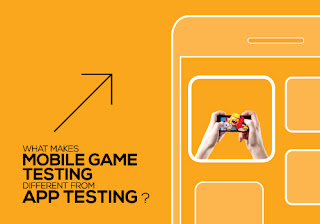Mobile game
applications are in many ways just like any other applications used
in mobile phones. But testing of mobile games and mobile apps has a
lot of differences. The main factor which leads to these differences
is that mobile games do not get a second chance with the users in the
normal scenario. The first impression of the game has a lot to do
with the continuous use of the game by the user. Users will not be
likely to download newer versions of a game with lesser bugs after
they have already deleted it.
Here are some ways
in which mobile game testing differs from mobile app testing:
Tailor made
testing methodologies:
It is hard to define
a standard strategy for game testing as each game differs from the
other with respect to game play and design complexities. Testing
methodologies need to be tailor made for each game. But, in common,
every game has to be tested on aspects such as usability,
functionality, endurance, regression, compatibility, hardware,
content testing, performance, recovery scenarios and localization or
internationalization.
Unique challenges
Mobile
game testing methods have significant differences compared to
app testing because of the unique challenges that one faces while
doing it. Help of domain specialists in technical areas such as
physics, graphics, and audio will be required to bring up specific
test approaches to test the subjective and crowd pleasing qualities
of the mobile games.
Functionality testing of the game is basically associated with the manual testing
and playing of the game. It checks if the user interface gives a good
visual appeal, and also checks usability and user experience of the
game. Performance testing of the game depends on the nature of the
game, game play, graphics, multiplayer functionalities and many other
things. It mainly looks into the CPU load, memory consumption and
frames per second (FPS).
Compatibility
testing is done to ensure that the game will run on all the different
devices and operating systems. It can be done using software
emulators, and on compatible mobile devices to make sure the game
works properly everywhere. Localization testing is also highly
important in game testing as it ensures that the game works well in
all supported languages. Along with these, other tests such as audio
testing, network testing, social integration, security and
liabilities testing, physics testing, beta testing, regression
testing, realism testing, and fun factor testing have to be carried
out to make sure the game gets good response from users.
Look and feel
With mobile app
testing, the effort is not as much as mobile
game testing. A game has to appeal the audiences besides being
flawless and free of bugs. The visual look and feel also needs to be
really good for a game to click. The pressure is not so much for
mobile apps. For businesses, a working app is enough to be released
on the stores. With time, the developers get chances to update it,
add new features, and enhance it to something even better. But, with
games, one can rightly say that the first impression is the last
impression if you don't get it right!

You have provided very nice information. Thanks for sharing. Learn more about Game Qa Services
ReplyDelete